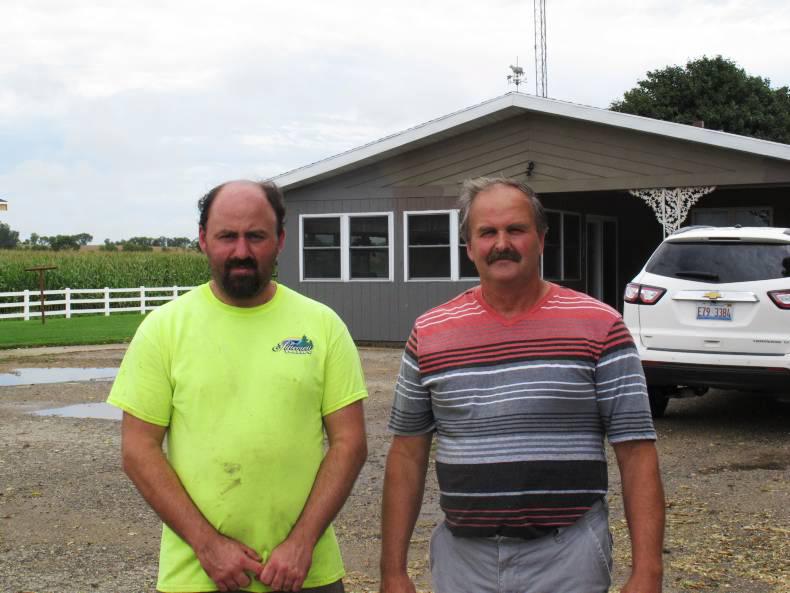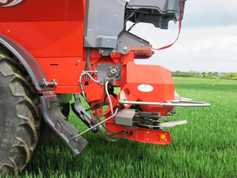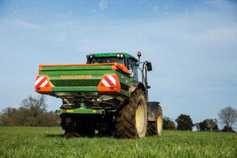Wisconsin is the home for high-producing dairy cows in the US. The majority are fed and milked indoors all year round. One of the main products made from the milk is cheese, and the farms range from the family business, accommodating 150 milking cows, to industrial size properties with thousands of cows.
On my first farm visit, I met Steve Case and his wife, Elizabeth, who along with their son Craig own Pineview Farm, a 150-cow dairy near Footville, Wisconsin. Steve and Craig were just finished feeding the calves when I arrived. I was just in time to see them feed a bag of purchased colostrum to a newborn calf. All calves (photo, below) get a sachet of purchased colostrum. It costs $32 (€28) per calf, but it is guaranteed to have the right amount of IGG antibodies and its Johnes free. The cost is small compared to the value of calves in the US at the moment. The Holstein Friesian bull calf Craig was feeding was worth up to $500 (€440). He had taken six calves to the mart the week before and came back with a cheque for over $3,000 (€2,660). A cull cow is worth $1.04/lb ,so the majority of culls were coming into $1,800 (€1,600), while a well bred in calf replacement can be purchased for $2,200 (€1,950).

The Case herd were averaging 85lbs (38kg) of milk per cow per day on a forage diet of one third haylage and two thirds corn silage (maize silage we call it in Ireland). Ryelage is also used – it’s a catch crop planted around now when the maize is cut and by mid-May next year it has a 10 tonne/acre crop of 22% crude protein material with a very high digestibility.
All maize and ryelage is stored in 200 foot long by 9 foot wide white silage bags that are packed up tight.
We continued our farm tour and the next shed we looked into had 66 replacement heifers at various stages of growth. Some bred, some heavily in calf and some on heat.
Craig explained: “There are over 300 head of stock on the farm in total and we estimate it is taking about 500 acres of crops to feed all the animals”. In total, they were farming over 600 acres but Craig was doing a bit of contracting in his spare time with some recently purchased machinery.
Similar to Ireland, land price lifted significantly on top of a housing boom but, as happened in one field near, this farm not all the houses were built. Just four years ago, Steve bought fifty acres adjoining the farm that had planning permission for a 120 house development that never happened. Steve and Craig bought the land for about $6,500 per acre (€5,700).
Milk price is holding up in the US and this farm were getting $18 per 100lbs (35 c/litre) at the moment, which isn’t bad relative to the world export market, but a long way back from what they were getting this time last year, which was closer to $27/100lbs (54 c/l). Last year a new concrete silo was built, but all development is on hold this year as Steve makes out the farm will just about breakeven at the 35c/l milk price.

Maize silage harvesting (photo above) had started and yield was good at 25 tonnes per acre bushelling 180 to 200. This is much better than the yield of 7 tonnes per acre in 2012. All milk from this farm is sold to Decatur Dairy, which is located just 12 miles over the road at Brodhead. This specialist cheese company make 70,000lbs of milk daily into all sorts of flavoured cheeses from Colby Swiss to Monterey Jack.
Steve’s son had built a new double up, rapid exit milking parlour for the family farm seven years ago and Steve and Craig had white tiled the inside walls so it was spotlessly clean. Records showed somatic cell count (SCC) was running at about 200,000 cells/ml, with protein percentage around 3% and fat around 3.70%. The chart on the wall showed the daily collection consistently at 10,800kg per day. Cows are housed in sand bedded cubicles with fans blowing cool air in and misters spraying water on cows near the feed face when it’s very warm.
To provide enough of feed about 200 acres are owned, 200 acres leased and 200 acres are on annual rent. Steve said: “Craig and myself invested in our milking herd and buildings rather than buy land, but it is possible to lease good land for crops nearby if is managed well. Cost varies depending on quality but can be in the region of $150 to $250 per acre. A lot of farmers around here have 600 to 700 acres and they lease out the farm for cropping rather than farming the land themselves.”
Five generations on Larson family farm
Not far over the road from the Case family farm, I called to Larson Acres, Inc, where six Larson families spanning five generations combine their interests, efforts, and enthusiasm to operate a dairy business near the Town of Magnolia.
I had just arrived in the door when Mike Larson explained he had forward sold a good portion of his milk supply for January to June 2016 the day before I arrived. He had phoned his broker and explained to him how many contracts or how much milk he wanted to sell. Each contract is for 200,000lbs (90,000kg) of milk. His broker then went off and made contact with their trader on the floor of the Chicago Mercantile Exchange, got a guide price for what the milk was worth if forward sold now, for delivery three months later.
Mike said: “We are taking a view that the market is going to get a little worse than better in the short term, so we are trying to insulate the business. It means if milk price rises very high we lose out, but that’s the risk you take.”
The Larson business now milks 2,400 cows and farms over 5,500 acres of crops to feed the animals. The feed storage area is almost seven acres in size and mountains of maize and grass silage were stored for the cows. While I passed, there was a lorry on the weigh bridge with corn gluten and another lorry pumping off liquid whey for feeding. The maize silage pit was uncovered and the John Deere’s lay idle as staff waited for the morning dew to dry off before harvesting restarted.
As we made our way to the calf house, we passed a 12 million gallon liquid slurry lagoon and Sandy explained that the contents would soon be pumped out to the fields as soon as the maize silage was cut. Sandy pointed out that she had a soil sample for each field, so she could use the nutrients to balance the soil fertility and make the most of the liquid manure. On this farm it was all sand bedding in cubicles, so the solids (sand and dung) have been removed and the liquid is pumped to the fields.
We arrived at the calf shed where the staff were just cleaning up after the first morning feed. Young calves are fed three times per day (2 litres per feed in buckets). Why three times per day? Sandy said: “it gives staff a chance to herd them properly in the warm and humid Wisconsin weather, and we find it’s better for the calf to get small feeds rather than big volumes at the one time.”
Calves start off in single pens, then share with another calf, then pens of eight and finally pens of 16 in large straw bedded pens. The baby calves are in plastic individual pens that can be dismantled and arranged in long, low roofed sheds with a wide central passage that has no side walls. Side sheeting can be lowered if the weather is bad, but really there is just an umbrella on top of the calves as it gets very warm during the summer.
A group of five staff work split shifts to feed and bed the calves. Calves stay under this control until they are five months of age. All heifer calves are genomically tested ($40/calf (€35)) and when they are old enough some of the best calves go to a ‘calf grower’ for contract rearing. Sandy said the genomic information allows the Larson’s keep their best calves for growing and improving the milking herd. She said: “In 2010, when we were increasing the milking herd, we bought virgin heifers with no data so having the information makes for much better decision making.”

We arrived into the temperature controlled shed (photo, above) where the majority of the cows are housed. There were 185 large fans along the length of the 400m shed blowing hot air out of the shed. Every day eight calves are born in this shed, all year round. Two milking parlours, a 20 unit double up and 22 unit double up harvest milk from the 2,400 cows three times per day. The milk is pumped directly into trucks that are reversed into the dairy, so no bulk tank is required. Five trucks leave the farm every day to Grande dairy which is 15 miles over the road. Grande specialise in mozzarella and pizza cheese.
Milking is a three person shift, with two full time milking and one person – a ‘pen pusher’, bringing cows to and from the parlour. In the parlour, staff told me it takes about seven hours to milk the 1,300 cows and one hour to wash up. I asked Sandy if hiring staff was a problem, and she replied that staff are an issue for every business, so you have to manage them properly and ensure they know what they have to do and how to do it. In this parlour, cows were meticulously prepared for milking and all information was recorded so management was top class.
I watched the clock as a cow milked 47lbs (21kg) of milk in 4.8 minutes, so at three times per day she was probably yielding close to 150lbs (68kg) of milk per day. The feed rail has head locking gates which allows cows to be locked up so staff can manage the cows.
When I walked through the shed, there were two farm staff, one on the outside reading the tag numbers, and one on the inside injecting BST hormone to suitable cows. Depending on stage of lactation and health of the cow, the milk producing hormone is administered.
I have to say, while it was warm and uncomfortable outside, it was perfectly calm and cool inside the shed. The only sound was a feed truck spilling out breakfast, and there wasn’t a sound from the cows as they wandered around from the feed face to the sand cubicles.
The scale was frightening, as the long feed passages looked never ending, yet Sandy was able to pick out her daughters show cows and give me pedigree and name. It is clear the Larsons are adept at managing large stock numbers and have the facilities in place to make the job possible. Cows can move to and from the milking parlour through passages that make cow movement easy.
The Larsons grow all their own forages with half of the 5,500 acres owned and half leased. Only three fields, a very small percentage of the land, is irrigated. Sandy’s brother manages the sowing and harvesting staff. However, from my visit it is clear that this dairy farm is very much a business, with meetings timetabled every week to ensure all managers know exactly what is going on and what needs to happen to get the best results. Larson Dairies has been around for a while, and it is not going away.







 This is a subscriber-only article
This is a subscriber-only article
















SHARING OPTIONS: